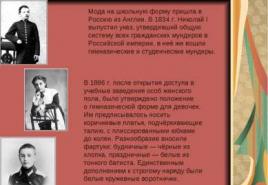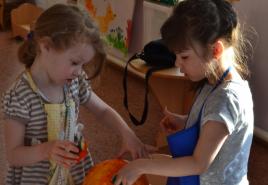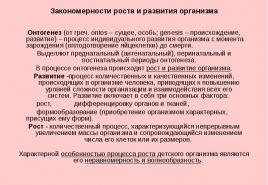A presentation on critical age periods. Presentation, report age physiology
Slide 1
Slide Description:
Slide 2
Slide Description:
Slide 3
Slide Description:
Slide 4
Slide Description:
Slide 5
Slide Description:
Slide 6
Slide Description:
Slide 7
Slide Description:
Slide 8
Slide Description:
Slide 9
Slide Description:
Slide 10
Slide Description:
Slide 11
Slide Description:
Slide 12
Slide Description:
Slide 13
Slide Description:
Slide 14
Slide Description:
Slide 15
Slide Description:
Slide 16
Slide Description:
Slide 17
Slide Description:
Slide 18
Slide Description:
Slide 19
Slide Description:
Slide 20
Slide Description:
Slide 21
Slide Description:
Slide 22
Slide Description:
Slide 23
Slide Description:
Slide 24
Slide Description:
Slide 25
Slide Description:
Features of vision in newborns At the 3rd week of intrauterine development, an eye is laid. When a child is born, it can be visually seen that the child's eyes are relatively larger than the body weight. the vision of a newborn obeys the 20/100 formula - this means that the baby can see an object if it is at a distance of 20-30 cm from his face and at eye level - no more. The kid sees objects somewhat blurry. For the first two weeks, the baby sees very badly, his eyes are only able to distinguish colors only at the "brighter-darker" level - this is because the muscles of the eye of the crumbs are still very weak, in addition, neural connections between the optic nerve and the occipital are not fully formed part of the cerebral cortex. Eye movements at birth are not yet coordinated. Every day the baby learns to focus his eyesight on objects of interest to him. In newborn babies, the eyes may mow a little: they converge "in a bunch" or scatter in different directions - this should go away later. And only by the 2nd week, the so-called "visual concentration" can be observed in the child. Tracking an object or a moving object with a gaze functions by 2 months, and at 3 months binocular vision is already developed, that is, the child fixes the object with his gaze and traces its movement with two eyes. The pupil's reaction to light is manifested in the fetus as early as 6 months. Some researchers believe that during the first weeks the baby sees a "flat" picture, there is no perspective effect, and it is inverted. farsightedness is inherent in all newborns, which is why they see distant objects better. The small width of the field of vision allows the baby to see only objects "in front of him", but if you move them sideways from the face of the crumbs, he will cease to see them. The ability to raise and lower the eyes in order to see an object in a vertical plane will come to him a little later - closer to the fourth month of life.
Slide 26
Slide Description:
Slide 27
Slide Description:
Slide 28
Slide Description:
Slide Description:Features of the heart of an infant In children, there is a continuous growth and functional improvement of the cardiovascular system. The heart of a newborn has a flattened oval or spherical shape due to insufficient development of the ventricles and the relatively large size of the atria. Due to the high position of the diaphragm, the heart of the newborn is horizontal. The right and left ventricles are the same in thickness, their walls are 5 mm. The atrium and great vessels are relatively large. In young children, the heart muscle is undifferentiated and consists of thin, poorly divided myofibrils, which contain a large number of oval nuclei. There is no transverse striation. The parts of the heart also grow unevenly. The left ventricle significantly increases its volume, by 4 months it is twice the weight of the right one. The heart takes an oblique position by the first year of life. By the end of the first year, the weight of the heart doubles. In children, the heart is located higher than in adults. The heart mass of boys in the first years of life is greater than that of girls. Only by the age of 10-14 does the heart acquire the same shape as that of an adult.
Slide Description:Features of the child's respiratory system The nose, like the entire facial part of the skull, is relatively small in a young child. The nasal passages are narrow. The lower nasal passage in children of the 1st year of life is almost absent, since the lower shell protrudes in the form of a small roller. Choanas are relatively narrow, which predisposes to rhinitis. The mucous membrane of the nose in young children has a delicate structure. It is richly supplied with small blood vessels, and therefore even a slight hyperemia leads to its swelling and an even greater narrowing of the nasal passages, which makes breathing through the nose difficult. The lacrimal duct at an early age is wide, which contributes to the penetration of infection from the nose and the occurrence of conjunctivitis. In newborns, the lymphatic ring is insufficiently developed. In children of the 1st year of life, the tonsils are located deep between the arches and do not protrude into the throat cavity. The larynx in newborns and young children, compared to adults, is relatively short and wide, funnel-shaped, with delicate, pliable cartilage and thin muscles. It is located high. The larynx grows especially intensively in the 1st year of life and during puberty. The trachea in a newborn is slightly higher than in an adult. The bronchi are a continuation of the airways. In the first year of life, the number of muscle bronchi is small.
Slide 33
Slide Description:
Slide 34
Slide Description:
Slide 35
Slide Description:
Age periodization. Age periodization. Over 90 centenarians. 75-90 old age. 60-75 old age. 35-60 2nd period of adulthood. 21-35 1st period of adulthood. 17-21 late adolescence. 15-17 early adolescence. 11-15 adolescence. 7-11 primary school age. 3-7 preschool age. 1-3 early age. 0-1 infancy. Age periods differ in relativity, convention, averaging, but each specific person takes his place. During the transition from one stage to another, psychological crises of development can arise - special periods of ontogenesis, characterized by psychological changes. The form, duration, and the severity of the course of crises are individual. The essence of development is the fundamental difference between development and other changes - the presence of not only quantitative, but also qualitative changes, the appearance of new formations - new mechanisms.
Slide 64 from the presentation "The subject of developmental psychology" to psychology lessons on the topic "Branches of Psychology"Dimensions: 960 x 720 pixels, format: jpg. To download a free slide for use in a psychology lesson, right-click on the image and click "Save Image As ...". You can download the entire presentation “Subject of Developmental Psychology.ppt” in a zip-archive of 2206 KB.
Download presentationBranches of psychology
"Existential Psychology" - Existential Psychology. Origins. Guilt. Martin Heidegger. The existentialist declamation. Seren Kierkegaard. Definition. Existential psychotherapy in Russia. Jean-Paul Sartre. Rollo May. Understanding time. Understanding a person. Existential Analysis. Edmund Husserl. Regular educational projects.
"The subject of developmental psychology" - XIX century. The main directions of efforts to activate the child's speech. The emergence of new activities. The social situation of development during maturity. The main lines of influence of the game on the development of the psyche. Dependence. The social situation of personality development in youth. Only in the XVI-XVII centuries did special children's clothing appear.
"Legal Psychology" - Signs of criminal behavior. Stress: types, phases and recommendations for self-regulation. Professional deformation. Psychological features of the inspection of the scene. Communication in the professional activity of a lawyer. Model of the communicative process. Interdisciplinary connections of legal psychology. The structure of the conclusion of the forensic psychological examination.
"Engineering Psychology" - Diagnostic Tasks. Engineering psychology is related to related fields of knowledge. Ergonomics. Development prospects. Object, subject and tasks of engineering psychology. Methodological principles. Stages of development. Operational tasks. The tasks of engineering psychology. Ergonomics object system. Psychodiagnostic methods.
"Special Psychology" - Typhlopsychology. Developmental deviations are very different. Introduction to Special Psychology and Pedagogy. The training system is built on the basis of the data of special psychology. The number of children and adolescents is increasing all over the world. Researchers. Tasks of special psychology. Various approaches to the classification and characterization of the contingent.
Age What happens to the immune system Dangers that threaten a person 1st critical period: from birth to 29 days Your own immune system is not formed. The body of a newborn is weakly resistant to microbes and its own immune system is not formed. The body of a newborn has little resistance to microbes and viruses. viruses. Severe viral and bacterial infections may appear up to blood poisoning. Severe viral and bacterial infections may appear up to blood poisoning.

Age What happens to the immune system Dangers that threaten a person 2nd critical period: 4-6 months of life Maternal antibodies disappear. If microorganisms "attack" the child's body, his immune system can already give a primary immune response, which is accompanied by the production of immunoglobulins M, which do not leave an immunological memory. However, due to the deficiency of immunoglobulin A, the risk of developing infectious diseases remains. Maternal antibodies disappear. If microorganisms "attack" the child's body, his immune system can already give a primary immune response, which is accompanied by the production of immunoglobulins M, which do not leave an immunological memory. However, due to the deficiency of immunoglobulin A, the risk of developing infectious diseases remains. Children are highly sensitive to respiratory infections, influenza virus, hepatitis. Measles and whooping cough are atypical, leaving no immunity. Allergic reactions are aggravated. Hereditary diseases begin to manifest themselves. Children are highly sensitive to respiratory infections, influenza virus, hepatitis. Measles and whooping cough are atypical, leaving no immunity. Allergic reactions are aggravated. Hereditary diseases begin to manifest themselves.

Age What happens to the immune system Dangers that threaten a person 3rd critical period: 2nd year of life The ability of the immune system to respond to a pathogen without developing immune memory (immunoglobulin M) is preserved. The immunoglobulin A production system remains undeveloped. The ability of the immune system to respond to the pathogen without developing immune memory (immunoglobulin M) is preserved. The immunoglobulin A production system remains undeveloped. During this period, the child's contacts with the outside world expand. Children become sensitive to viral and microbial infections, which they can get sick more than once. According to the degree of development of the immune system, children are not ready to stay in a children's team. During this period, the child's contacts with the outside world expand. Children become sensitive to viral and microbial infections, which they can get sick more than once. According to the degree of development of the immune system, children are not ready to stay in a children's team.

Age What happens to the immune system Dangers that threaten a person 5th critical period: adolescence New age (girls 12-13 years old, boys 14-15 years) During this period, growth spurt is combined with a decrease in the protective properties of the immune system. In addition, the production of sex hormones leads to suppression of the immune system. During this period, a growth spurt is combined with a decrease in the protective properties of the immune system. In addition, the production of sex hormones leads to a suppression of the immune system. The production of immunoglobulin E decreases, so allergic skin dermatitis disappears, but the sensitivity of children to tuberculosis and some other infections increases, and the incidence of chronic diseases increases. The production of immunoglobulin E decreases, so allergic skin dermatitis disappears, but the sensitivity of children to tuberculosis and some other infections increases, and the incidence of chronic diseases increases.

Age What happens to the immune system The dangers that threaten a person 6th critical period: old age With age, a number of chronic diseases that weaken the body accumulate. There is a decrease in the protective properties of the immune system. Chronic diseases are aggravated.


1.Use natural factors for hardening: the sun, air, water, the difference in ambient temperature. 2. Remember: the main thing is to gradually increase the time of exposure to the body and the dose of any of the hardening factors. 3. Be sure to consider your strengths and individual characteristics when choosing hardening procedures. 4. Hardening will only lead to success when it is carried out systematically, regularly! 5. It is necessary to alternate and combine different hardening procedures; 5. It is necessary to alternate and combine different hardening procedures to achieve the best results. treatments for best results.

6. Combine hardening with active movements - physical exercises, sports, create a positive emotional mood for yourself - this will help you enjoy the procedures! 7. Do not forget, you cannot carry out the hardening procedure immediately after eating. You must either wait 1.5 hours or start 1.5 hours before meals. 8. Be sure to control your health during the procedures. It should remain consistently good both during and at the end of the procedure, in the process of training all the main life support systems are turned on, which leads to an increase in their functional reserves.


Purpose: to acquaint students with the periodization of human life, to summarize the material on the influence of various factors on growth, development, aging; deduce the patterns of age-related changes from the factual material.
Equipment: reproductions of paintings by Da Vinci "Madonna Litta", Zh-B. Dreams "Girl in Gray", V.E. Makovsky “Girl in Ukrainian costume”, V.E. Yaroshenko "The student of the course", V.G. Perov “A boy preparing for a fight”, V.I. Surikov “Siberian beauty”, V.A. Serov “Girl illuminated by the sun”, I.N. Kramskoy “Portrait of I.I. Shishkina ”, I.N. Kramskoy “Portrait of I.A. Goncharova ”, IN. Kramskoy "Peasant with a bridle", V.G. Perov "Old men parents at the grave of their son"; graphs, tables of age changes.
The chalkboard lists the different age categories.
Teacher: Today we will get acquainted with the features of post-embryonic human development. In everyday life and in literature, we repeatedly come across the concepts: age of milk teeth, one year old, marriageable age, preschooler age, age of majority, age of "why", age of the voter, age of complete ossification, age of Christ.
What groups can be distinguished in this list, on what basis should they be classified? (concepts that determine biological age, psychological, social). Age means:
- calendar age - life expectancy;
- biological - the age of development, maturation, aging, is determined by the totality of metabolic, structural, regulatory processes;
- psychological - the level of development of mental functions (thinking, speech, etc.) in comparison with the average statistical norms;
- social is defined by a set of social roles.
Setting the goals and objectives of the lesson:
Today we will summarize knowledge about the regulatory mechanisms of growth, development, aging, establish the patterns of age-related changes, establish the relationship between different age concepts.
Organization of work in groups. Each group receives a set of reproductions, texts on age periodization, excerpts from literary works and scientific articles, a package of tasks.
Based on the materials offered to you, formulate what factor affects growth, development, aging, argue your theses with facts.
For normal growth of the skeleton, a sufficient amount of thyroid hormones is needed, they affect the growth and development of the sex glands. Thyroxine is necessary for the differentiation of nerve cells, increasing the tone of the reticular formation, thyroid hormones have an activating effect on the cerebral cortex. With a deficiency, dwarfism, cretinism develops. Lack of hormone-hypothyroid glands causes disturbance of bones, hair, nails, conditioned reflex activity changes. The sex hormones of the adrenal glands are involved in the development of sexual characteristics, especially their role is great in old age and childhood. Androgens of the gonads affect the secondary sexual characteristics, the rate of closure of the epiphyseal growth zones. With insufficient secretion, bone growth slows down, body proportions are disturbed. The male sex hormone has a pronounced effect on higher nervous activity.
The growth of an organism depends on heredity. Children grow most actively in spring and summer: 3-4 times faster than in winter. Experts call the time of especially rapid growth the period of physiological extension, the first falls on 5-6 years, the second on 12-14. Nature provides a unique opportunity to grow in height only up to a certain age: girls up to 16-18 years old, boys up to 18-20. After that, the body does not grow, since the growth zones ossify and close. With age, the reverse process is gaining strength. Over the years, a person begins to slouch, and the bones become more porous and seem to be compressed under the weight of the body. After 50 years, growth begins to decrease by about 1 cm. in year. Good nutrition affects growth. The body stops growing , if he lacks calcium salts, phosphorus, trace elements: zinc, magnesium, fluorine. Lack of vitamins alters growth and development. Lack of vitamin A slows down growth, causes night blindness, B 1 - damage to the peripheral nerves of the extremities, B 2 - weight loss, B 6 - nervous disorders, B 12 - causes a disease of the nervous system. E- changes in gonads.
Text 3
At the beginning of the 20th century, a person walked 75,000 km in his life, a modern city dweller only 25,000 km. Doctors talk about a painful state of inactivity. Muscle strength and bone strength, the reliability of the immune response, metabolic activity, the state of the heart, blood vessels, and lungs depend on everyday loads. Due to a decrease in muscle mass, the capacity of the entire vascular system decreases, the number of working capillaries in the heart and skeletal muscles decreases. Calcium is washed out of bones and teeth in those who do not exercise much. Bones become brittle and brittle, teeth have to be treated frequently. Exercise is essential for all ages, but especially during adolescence, as it helps to overcome body imbalances.
Text 4
There are differences in the life expectancy of men and women. The average life expectancy is longer for women, but the health of older women is worse than that of men of the same age. There is, as it were, a selection of the healthiest men due to their higher mortality; although women achieve longevity in a relatively large number, they have a burden of past diseases. In men, atherosclerosis begins to progress early, mortality in men at the age of 40 is 7.4 times higher than in women. Sexual dimorphism also exists in many characteristics of vital activity (blood pressure, heart function, pulmonary ventilation, hormone, protein, lipid content).
Longevity is influenced by the interaction of 2 components: genetic factors and the environment. Among the possible influences of social factors, in the first place are personal activity, mood, adaptation, from medical - the absence of risk factors (diabetes, hypertension), from environmental - place of residence, the influence of the environment.
Text 5
In 1920, 2 girls were found in India who had lived in a wolf family for several years. They ran only on all fours, were very afraid of people, prowled and howled like wolves at night. The eldest only spoke the first word after 2 years, after 3 years she tried to get back on her feet, and after 2 years she spoke 6 words. After 8 years, I began to hardly pronounce short, simple phrases. She spent 9 years in a missionary shelter (from 8 to 17 years old). It is believed that she would reach the level of a 10-12 year old child by the age of 35-40. To date, more than 40 cases of the capture of "wolf children" have been described. Human ability to walk on feet, the ability to speak and accumulate knowledge undoubtedly has an innate basis. But the corresponding nervous mechanisms are turned on only if the child communicates with adults, gradually adopts their behavior. If a critical period is missed (from several months to 2 years), then speech will not develop. The possibility of further development into a normal human personality is excluded.
Text 6
The left and right hemispheres of our brain have different functions. The left is responsible for speech, writing, counting, logical thinking, the right provides the perception of holistic images, is responsible for artistic abilities. A person is not born with functional asymmetry, it is formed from writing: exercise activates the left hemisphere. If a person remains illiterate all his life or is engaged in routine interhemispheric work, he does not develop asymmetry. It fades away and smoothes out in old people who cease to engage in intense mental activity. On the contrary, when a person solves a problem that requires mental effort, the asymmetry increases.
Teacher: Scientists, trying to explain how human life unfolds, how the interaction of genetic factors and the environment occurs, proposed a model. It's called the “landscape of life”. Imagine a slope with hills and hollows, along which a ball is rolling - a developing organism. The terrain imposes certain restrictions on the movement of the ball as it descends. An occasional depression or hillock changes course. The model illustrates that there are natural development paths, but the environment influences the route in unpredictable ways. Our life is a chain of continuous transformations, the onset of biological age is determined by changes in bones, teeth, metabolic processes. To highlight the stages, psychologists took as a basis the qualitative changes associated with the ability to act not only better and faster, but most importantly in a different way. Scientists distinguish periods of crisis: sensitive (sensitive), when certain functions develop according to the principle “better now than later”. Critical periods have a "now or never" principle.
Teacher: at the second stage of the lesson, you have to determine the patterns of age-related changes using charts and tables.
Group 1. Age-related changes in heart rate (HR) and stroke volume.
Index |
Newborn. |
Age (in years) |
||||||||||
Heart rate (Pulse per minute) |
||||||||||||
Stroke volume of the heart |
||||||||||||
Newborns have the highest heart rates and a minimum stroke volume of 2.5 cm3. In the first year of life, the stroke volume increases 4 times, over the next 5 years, 2 times. In a 15-year-old, the heart rate corresponds to adult indicators, it is almost 2 times less than in a newborn, and the stroke volume is 20 times greater.
L. Tolstoy said figuratively about the pace of change: “There is only one step from a 5-year-old child to me, a terrible distance from a newborn to 5-year-old. From the embryo to the newborn - the abyss ”.
Group 2. Age-related changes in the vital capacity of the lungs (VC) from 20 to 80 years.
Women and men have initially different indicators. General tendency: maximum indicators at 25 years old, decrease after 35. After 45 years, the decrease in VC is more pronounced in women. The maximum indicators for men are 3800, for women 3000. The minimum indicators are 75 for men 3000, for women 1800.
Group 3. Changes in some signs of a person with age. (Appendix 1)
General trends:
1) Decrease in performance from 35 years old;
2) Periods of decline alternate with periods of relative stabilization;
3) Changes in each system have their own critical years and are not simultaneous for the organism as a whole.
For scientific texts, select literary excerpts and reproductions of paintings.
Group 4 Text.
Infancy (up to 1 year old)
Biological changes: overgrowth of the fontanelle, maturation of the muscles of the neck and trunk, the child can hold his head, tries to sit; maturation of the muscles of the legs allows you to move independently, first crawl, then get up. At 2 months, a smile appears. There is visual and auditory concentration, at 3 months - "humming", at 6 - the beginning of babbling and understanding your name, at 9 - joint play activities with adults, mastering a gesture of farewell, at 12 - understanding some generalized commands. Binocular vision is being formed (from 13 weeks to 2 years). If a child has strabismus or one eye is damaged and the defect cannot be eliminated during this time, then this person will never fully see.
Early age (1-3 years old).
Self-familiarization with the environment, through trial and error, different methods of action are mastered. The child learns the symbolic properties of objects, imagining that the cube is a machine, and the doll is a person. By the age of 1.5 he pronounces 100 words, at 2 years - 300, at 3 years - 1500 words. In the second year, children learn to speak, understand the symbolic meaning of words. This is illustrated by S. Marshak's lines:
When, having experienced the difficulties of teaching,
We start to put words together
“Water. The fire. Old man. Deer. Grass".
And we understand that they have a meaning ...
The next age is usually called preschool childhood... The child quickly expands his capabilities: he eats, dresses, learns to ride a bike, draw, cut with scissors. He masters the first abstractions: geometric shapes, calendar, time. Account, letters. The vocabulary is 2000 words. Asks a lot of questions. S. Marshak, characterizing this period, wrote:
He harassed adults with the question "why?"
He was nicknamed "the little philosopher" ...
Junior school age (7-10 years old).
The whole way of life changes dramatically, constant responsibilities appear, the circle of communication expands. By the beginning of the education, the child develops a certain self-esteem, manners of work, and skills in relationships with others. The last period of childhood proceeds smoothly, without any crises. This age accounts for a minimum of diseases and psychological trauma. Friendship is born, the first betrayal shocks. They develop their own ideas of what is “good and what is bad”.
Adolescence - transitional (12-15 years old).
Puberty leads to the growth and imbalance of body parts, hormonal status changes, and secondary sexual characteristics are formed. Man does the work of restructuring the soul himself. The teenager is absorbed in himself, he is tormented by fears, doubts. M. Tsvetaeva figuratively expressed this in verse.
Ringing - singing, depriving oblivion,
In my soul the words: "fifteen years"
Oh, why did I grow up big?
There is no escape! ...
What's ahead? What a failure?
Everything is deceit and oh, everything is prohibited!
So with a sweet childhood, I said goodbye crying
At fifteen.
In a short period, he turns from a child to an adult. The body, psyche, relationships with others are changing, this does not happen simultaneously. A biologically mature person can remain a child for many years due to his state of mind and position in society. The difficulties of adolescence are associated not only with physiology. The position of the adolescent in our culture is ambiguous. In ancient times and in surviving archaic cultures, a person who reached puberty became a full member of society. In the Masai, at the age of 15, a teenager is being prepared for the transition to the group of tribal defenders - the status of an adult. Transition - initiation is accompanied by tests. Woe to the one who reveals with a sound how it hurts, then he will remain an eternal child, will carry out any assignments of his peers. In the 18-19 century in Russia, a 10-year-old girl was left with the whole house, looking after small children, and a 15-year-old became a full-fledged adult worker.
Text Youth (16-20).
Physiological maturation is completed (complete ossification occurs), appearance and well-being improve. A person acquires the fullness of physical and intellectual capabilities. There is no longer any difference between the thinking of a young man and an adult. Creative abilities flourish, at this time the highest achievements in sports. But age is characterized by anxiety, a heightened need for understanding. Loneliness, jealousy, resentment are experienced very sharply. The crisis is 17-18 years old.
Maturity. (20-65)
A long stage between adolescence and aging (from 20 to 65 years). Allocate: youth (20-30) - the time of self-affirmation in love, career, family, society. Pushkin A.S. wrote:
Am I soon thirty years old?
So, my noon has come ...
Stabilization period (35-43). Everything that has been achieved is consolidated. A person knows himself and his capabilities, appreciates the present day. Then comes a critical decade, depressive moods, fatigue from boring reality appear, life achievements are overestimated. People are going through a midlife crisis. Pushkin A.S. wrote:
But it's sad to think it's in vain
Youth was given to us
That they cheated on her every hour
That she deceived us
That our best wishes
That our fresh dreams
Decayed in quick succession
Like leaves rotten in autumn.
The period ends with psychological and physical balance, when there is a departure from active work and social life.
Older age (60-75).
All biological changes occurring during this period are unpleasant. The main task is to realize your age, to accept yourself as you are. The life position changes from active to passive. After 60 people perceive the world as more dangerous and complex than in their youth. Hence the characteristic features of the elderly: conservatism, caution, and legibility. This is the age of loss - friends, relatives, loved ones die. There is a special relationship with time. All his life he has been lacking, but now he must be “while away”.
Old age (after 75)
A noticeable deterioration in health, a decrease in body length, a pronounced increase in stoop, a decrease in muscle strength. The appearance of wrinkles.
A person rethinks his whole life, or accepts it as fate, or realizes that life has been wasted. Figuratively in the saying: "Old age is a fierce winter for the ignorant and a harvest time for the sage."
Teacher: Biological processes occur involuntarily, the restructuring of the soul depends on the activity of everyone, and the change in social status is provided for by the structure of society. A person in different periods masters social roles. The age of assimilation of such roles depends on the society. In the old days in Russia, 15-year-olds were considered independent adults, at the age of 20 they became statesmen. Now 20-year-olds are considered not mature enough to lead others, to be leaders in the professional sphere, to start a family. Different countries set different time frames for entering school, coming of age, selectivity, retirement. A person can biologically go through different stages, but not reach social maturity. The people say: “Who is a man at 10 years old, and who is a child at 40”. A person who has reached social maturity follows the norms of society, if he shares them, rebelles against them, if he does not agree. And sometimes he is able to change the most unshakable rules.
Teacher: what conclusions can we draw from the lesson?
- Age-related changes are due to various factors.
- The rates of age-related changes are individual.
- Age-related changes depend on gender.
- Age-related changes in different organ systems do not manifest themselves simultaneously, heterochronously.
- At the early stages of ontogenesis, the rate of age-related changes is several times more intense than at other times.
- Biological changes arise involuntarily, psychological ones depend on the activity of the individual, and the role and framework of social changes is set by society.
Homework: Find characteristics of different ages from literature sources.
Literature:
- Bezrukikh T.T., Sonkin V.D., Farber D.A. Age physiology M .: publishing center "Academy", 2002
- Smirnova N.S. V.D. Solovyova The biological age of a person- M .: Knowledge, 1986
- Tolstykh L. Ages of life. Moscow: Young Guard, 1988
- Khripkova A.G. et al. Age physiology and school hygiene-M .: Education, 1990
- Encyclopedia for children vol. 18 People. Part 2 - M .: Avanta, 2003







